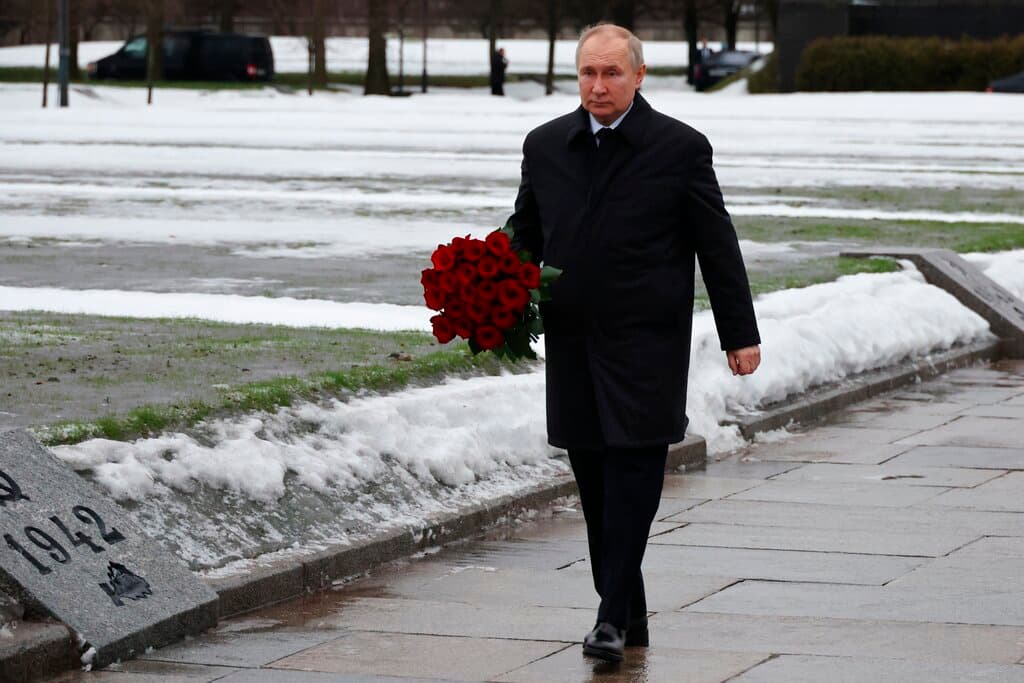Moscow Girds Against Aerial Attack
Russians reportedly have been sharing images of Pantsir S-1 anti-aircraft artillery systems being hoisted by large cranes onto the roofs of various buildings.

One month before marking a year since the start of the invasion of Ukraine, the human toll of the Russian belligerence is coming into clearer view. According to the Norwegian defense chief, Eirik Kristoffersen, Ukraine has suffered 100,000 military casualties and “about 30,000 civilians who have died in this terrible war.”
Speaking to the French television network TV2 on Sunday, Mr. Kristoffersen said that “Russian losses are beginning to approach around 180,000 dead or wounded soldiers.” As rage builds at Kyiv, Vladimir Putin may be fearing more problems: Air defense systems are now being installed on multiple Moscow rooftops.
The French newspaper Le Monde was among the first to report that Russians had been sharing images of Pantsir S-1 anti-aircraft artillery systems being hoisted by large cranes onto the roofs of various buildings at Moscow. Those buildings include Russian military headquarters and a printing plant. Among the seven such installations, one is on the ground just a few miles from Mr. Putin’s Moscow residence. According to a Russian website, that unit also included an S-400 missile system and a vehicle that can intercept cruise and ballistic missiles.
Le Monde reported that the Kremlin spokesman, Dmitry Peskov, referred questions about the development to the Russian defense ministry, which had no comment. It is believed that the Russian authorities put the air defenses into place over a two-day period around January 19 and 20. While this does not mean that Ukrainian attacks are imminent, it was enough for another leading newspaper, Italy’s La Stampa, to claim that “Moscow prepares for total war.”
Ukraine has not shied away from launching counter-attacks against Russian military assets within Russia. While these have largely been confined to Russian regions bordering Ukraine, such as Belgorod and Voronezh, this has not always been the case. Emboldened by successes on the battlefield and bolstered by Western-supplied weaponry, Kyiv has taken the fight much deeper into Russia.
In December, Ukraine launched two separate attacks in the Saratov region; the first of those targeted the Engels airbase and in the second three Russian servicemen were killed after air defenses shot down a Ukrainian drone.
Modern air defense systems appearing on rooftops in the Russian capital point to how the war is having unintended consequences in the place where it started — and underscores Mr. Putin’s failure to anticipate them. In an interview with London’s Guardian newspaper, Maria Pevchikh, the deputy of jailed Russian opposition leader Alexei Navalny, said of the Russian president, “He’s just quite basic. Putin is not some great thinker and strategist. He’s not exceptionally intelligent.” Mr. Pevchikh added that “he’s not subject to any logic or rational thinking.”
In a separate development, Boris Johnson paid a short visit to Kyiv on Sunday. In addition to meeting with President Zelensky, with whom the former British prime minister established a solid rapport while at Downing Street, Mr. Johnson addressed a group of students and professors at a Kyiv university. His pitch for getting more advanced tanks and weapons into Ukraine was clearly calibrated for both Brussels and a global audience. Ukraine should “seek its destiny in NATO,” Mr. Johnson said, because in his view the fact that it is not part of the military alliance “has led to the worst war in Europe in the past 80 years.”
“Do not listen to the arguments of those who talk about escalation,” he said, adding, “How can we escalate the confrontation, where one side is already using the most advanced modern aircraft to bomb residential areas? Ukraine deserves all the help possible.”
Speaking more like the leader that until recently he was and less like the rank-and-file Tory politician that he currently is, Mr. Johnson said, “We, your friends, will help you end this war as soon as possible in 2023. Because it will be the best thing for the world — so that people don’t die, and it will be the best thing for Ukraine and, frankly speaking, for the Russian people, too. Let’s get this thing over finally.”
That is optimistic language, considering that the chairman of the Joint Chiefs of Staff, Mark Milley, recently said that “from a military standpoint, I still maintain that from this year it would be very, very difficult to militarily eject Russian forces from every inch of Russian-occupied Ukraine.”
Moscow might have been more attentive to something else that the former British prime minister said at Kyiv: “I’m proud that we are the first country to send Challenger tanks, and we expect tanks from other countries,” Mr. Johnson said, adding, “We want to get aircraft for the people of Ukraine.”
Over the weekend Russia’s defense ministry issued this unusual statement: “In the Moscow region, a training session was held with the personnel of the anti-aircraft missile brigade of the Western Military District on repelling air attacks on important military industrial and administrative facilities.” About 150 soldiers participated in the drill, in which “an S-300 anti-aircraft missile system was involved in the training as combat was simulated.”
There can now be little doubt that, despite Kremlin denials, Moscow is incrementally girding for strikes on the capital. If the scenes of death and destruction that have befallen so many Ukrainian cities since the war began begin to haunt Moscow, could it pile the pressure on Mr. Putin to stand down and cut his losses?
That is exceedingly difficult to say, but in the meantime more battles are looming on the ground, in the heart of Ukraine. Chaos prevails in Donetsk, where the Russians have wrested control of Soledar, but the Ukrainian army has liberated the town of Lyman.
Questions loom over Zaporizhzhia, where the Russians are said to be preparing for renewed offensive action. On Monday, Russia’s head of foreign intelligence, Serhiy Naryshkin, accused Ukraine of storing advanced weapons at nuclear power plants with the expectation that Russia, ”understanding the danger of a nuclear catastrophe,” would not strike them.
Zaporizhzhia is one of four regions Russia illegally annexed last year, and is home to the largest nuclear power plant in Europe.

